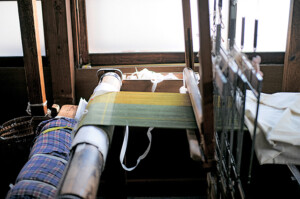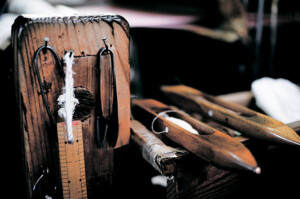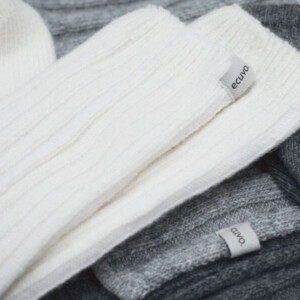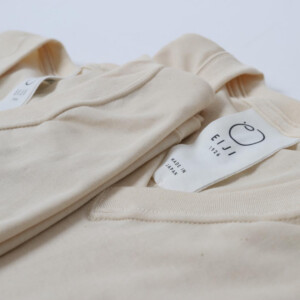
What kind of Kimono is Ueda Tsumugi? History and characteristics are explained in detail!
There are various types of pongee, but have you ever heard of Ueda pongee?
Ueda tsumugi is produced in Ueda City, Nagano Prefecture, and is known as one of the Shinshu tsumugi. The popularity of pongee grew around the Edo period (1603-1867), and each clan competed with each other in the art of pongee making. Among them, Ueda tsumugi was particularly popular. Today, tsumugi has been overshadowed by Oshima tsumugi and Yuki tsumugi, but it is a fascinating type of kimono with a history of more than 500 years.
In this issue, we will explain in detail the history, characteristics, and charm of Ueda tsumugi.
What kind of kimono is Ueda Tsumugi?

Ueda tsumugi, produced in Ueda City, Nagano Prefecture, is a silk fabric characterized by its rough texture. It has become popular because of its simplicity, texture, and durability.
Ueda tsumugi is dyed by herb dyeing
Generally, Ueda Tsumugi is dyed by herb dyeing, but in recent years, chemical dyes are often used to produce delicate shades. Incidentally, before herb dyeing became the mainstream, indigo dyeing was used for dyeing. People wearing Ueda tsumugi appear in Utamaro Kitagawa’s paintings of beautiful women, and the fact that they are all painted in indigo suggests that indigo dyeing was used in the past.
Ueda tsumugi is especially strong and durable.
Ueda tsumugi is known for its durability. Even if the lining cloth is changed three times, the outer cloth of Ueda tsumugi is said to last longer, and it was nicknamed “San-ura-jimai” (three-lined silk). It is said that “Sanada is strong, but Ueda is strong, too” in reference to Yukimura Sanada, a military commander in the area where Ueda silk is produced. and “Sanada is strong, but Ueda is strong, too! Ueda Tsumugi is stronger than other kimono fabrics, but Ueda Tsumugi is said to be the strongest among them.

Ueda Tsumugi has a history of over 500 years.
Ueda City in Nagano Prefecture is rich in nature and was originally a region where textile industries such as Sanada-ori flourished.
The silk industry began in the late 1600s. Each clan began to focus on sericulture as part of their industrial policy, and the silk weaving industry developed from there. In the area around Ueda City, silk weaving flourished when the Sanada clan encouraged Sanada-ori as a local industry, and the current form of Ueda silk was completed during the reign of Tadamasa Sengoku, the lord of the Ueda domain.

During the Edo period (1603-1868), the prohibition of extravagantclothingled to the popularity of simple silk pongee. Ueda pongee was especially popular among the Shinshu pongees, and it gained the status of Ueda pongee along with the name of Yukimura Sanada, a warlord of the Warring States period.
After the Edo period, Ueda Tsumugi was forced to downsize due to the change to Western-style clothing and the war, but the technique was passed down to the next generation. Thanks to their efforts, Ueda Tsumugi was designated as a traditional craft by the Ministry of Economy, Trade and Industry on February 17, 1975 as one of the Shinshu Tsumugi. It is also famous for the use of the Sanada family crest, Rokubun-sen, on the certificate issued by the Ueda Tsumugi Textile Cooperative Association.
Ueda tsumugi is characterized by its fine thread work and plaid and stripe patterns.
One of the characteristics of Ueda tsumugi is its durability, which is said to be so strong that it can be used even if the lining is changed three times, which is said to be created by the fine use of threads. It is precisely and carefully woven into the fabric that gives it its moderate firmness, bounce, and durability.
Also, the patterns such as lattice and stripes are often mentioned as the characteristics of Ueda silk. Not only fine lattices, but also many large lattices are expressed. The colors are not only simple navy blue and white, but also bright colors such as yellow, peach, purple, etc., and gradation lattices made with more than 50 colors.
Enjoy the charm of Ueda tsumugi
Ueda tsumugi is a pongee that has evolved into a new colorful pongee, stepping out of the realm of pongee that is often thought to be plain.
Scenes of wearing Ueda tsumugi
Although Ueda tsumugi is made of silk, it is still a pongee. It is suitable to be worn as casual street clothes, and can be worn for small outings, visiting museums, strolling in gardens, having dinner or tea with friends, watching a play, and so on. In particular, the brightly colored Ueda tsumugi goes well with museum tours. The unique colors, which are not too gaudy, will add a touch of flair to your art appreciation.
Obi and Obi Knot to match with Ueda Tsumugi
Basically, the obi to be worn with tsumugi is the Nagoya obi, but depending on the occasion, the Fukuro obi or the Shashabukuro obi can also be used. A dyed obi with a seasonal motif on it will give a sense of the season.
For a more chic look, why not try a variant of the obi knot? The three-dimensional obi knot called kakudashi (Ginza knot) looks great with the simple design of Ueda tsumugi. If the obi to be matched is simple and calm, please try to enjoy the fashionable way of tying the knot.
Conclusion

We have explained about Ueda tsumugi, touching on its history, characteristics, and charms, etc. How was it? Each production area has its own characteristics and has preserved its own techniques. Ueda Tsumugi reached its peak in the Edo period (1603-1867) and has been at the mercy of the history since then, but it has kept its techniques and has been connected to the present age.
In recent years, people have been moving away from wearing kimonos, so the company is now exploring new avenues of business such as Ueda Tsumugi fabric bags, taking advantage of the sturdiness of Ueda Tsumugi. Ueda Tsumugi bags are also beautiful, but I think they are more attractive when worn with a kimono. If you have Ueda tsumugi, please do not keep it in your chest of drawers, but wear it outside more and more.
Reference source: Shinshu Tsumugi|Traditional Crafts Aoyama Square
Reference source : Ueda Tsumugi|Ueda Tsumugi, one of the three major silk textiles in Japan




